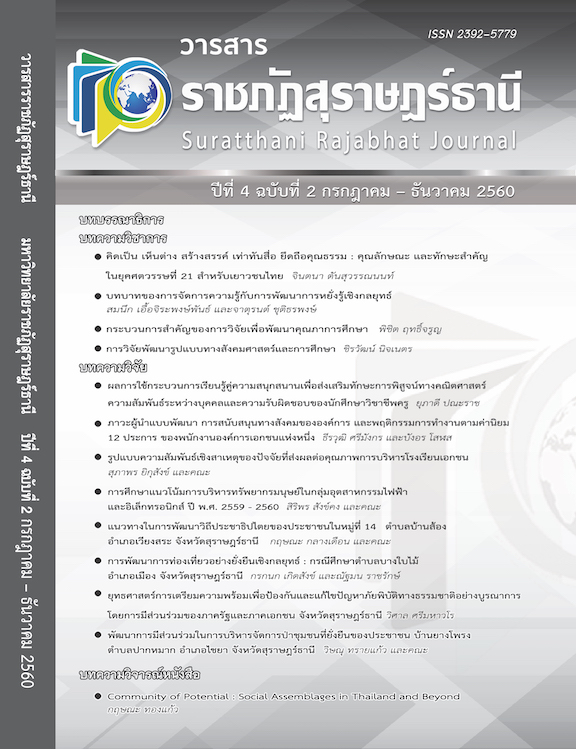The Effect of Applying Learning and Enjoying in Mathematics (5T Model) to Encourage the Skills of Mathematical Proof Interpersonal Skills and Responsibility of Pre-service Teachers
Main Article Content
Abstract
This study integrated teaching and research. The objectives of this research were to promote the skills of mathematical proof and study interpersonal skills and responsibility of pre-service teacher. The sample was 38 pre-service teachers in the Mathematics program, Faculty of Education, Kamphaeng Phet Rajabhat University (KPRU) who enrolled in the principles of mathematics courses in the first semester of academic year 2014. The instruments included the Learning and Enjoying in Mathematics (5T Model), the test of mathematical proof’s skills, and the questionnaire of interpersonal skills and responsibility. Data were analyzed by frequency, percentage, mean, standard deviation and t-test. The results showed that:
- Pre-service teachers had the skills of mathematical proof after using 5T Model and it was significance at .05 level higher than 70 percent. During the process of 5T Model, they had 83.74 percent on score of a group process and 74.39 percent on score of the individual practicing.
- Pre-service teachers had a total score and all items on interpersonal skills and responsibility at the highest level. The first three highest mean scores were all members who accepted the results of the activity willingly. All members were important to the achievement of the target activity, and everyone believed that every member of the group was able to do activities to achieve the goals. Moreover, they had the method to help their friends to comprehend what they have assigned as a self-study on the content. After that they explained, giving examples, asking and answering questions for clearly understanding. Whenever, they were delegated to do the test if they got the correct answer they felt self-esteem, gladness, and willingness to do more. However, they also felt regret when having a wrong answer, and they thought of having more study. On the other hand, when their friends were delegated to do the test, if the friend did the right or wrong answers, they expressed their great appreciation to all friends and encouraged in positive ways. Sometime they felt sad, but their friends did the best.
Article Details
Section
Research Article
References
ทิพย์ภาภรณ์ อินทรอักษร. (2554). ผลการเรียนแบบร่วมมือเทคนิค STAD ร่วมกับเกมคณิตศาสตร์ที่มีต่อผลสัมฤทธิ์ทางการเรียนคณิตศาสตร์ของนักเรียนชั้นประถมศึกษาปีที่ 6. วิทยานิพนธ์การศึกษามหาบัณฑิต สาขาวิชาหลักสูตรและการสอน บัณฑิตวิทยาลัย มหาวิทยาลัยทักษิณ.
ทิศนา แขมมณี. (2555). ศาสตร์การสอน: องค์ความรู้เพื่อการจัดกระบวนการเรียนรู้ที่มีประสิทธิภาพ (พิมพ์ครั้งที่ 15). กรุงเทพฯ : ด่านสุทธาการพิมพ์.
นันทชัย นวลสอาด. (2554). ชุดกิจกรรมการเรียนการสอน เรื่อง อัตราส่วนตรีโกณมิติโดยใช้วิธีสอนแบบร่วมมือด้วยเทคนิค STAD สำหรับนักเรียนชั้นมัธยมศึกษาปีที่ 4. ปริญญานิพนธ์การศึกษามหาบัณฑิต สาขาวิชาคณิตศาสตร์ บัณฑิตวิทยาลัย มหาวิทยาลัยศรีนครินทรวิโรฒ.
พิมพันธ์ เดชะคุปต์ และพเยาว์ ยินดีสุข. (2555). สอนเขียนแผนบูรณาการบนฐานเด็กเป็นสำคัญ. กรุงเทพฯ : จุฬาลงกรณ์มหาวิทยาลัย.
ยุภาดี ปณะราช. (2550). เอกสารประกอบการสอน รายวิชา หลักการคณิตศาสตร์. โปรแกรมวิชาคณิตศาสตร์ คณะวิทยาศาสตร์และเทคโนโลยี มหาวิทยาลัยราชภัฏกำแพงเพชร. อัดสำเนา.
______. (2557). การเสริมสร้างมโนทัศน์ทางคณิตศาสตร์ด้วยภาษาอังกฤษโดยใช้กระบวนการเรียนรู้คู่ความสนุกสนาน. วารสารครุพิบูล, 1(1), 12 - 21.
______. (2558). การพัฒนารูปแบบการสอนคณิตศาสตร์ที่เน้นกระบวนการเรียนรู้คู่ความสนุกสนาน. วารสารปัญญาภิวัฒน์, 7(2), 157 - 168.
วิจารณ์ พานิช. (2555). วิถีสร้างการเรียนรู้เพื่อศิษย์ ในศตวรรษที่ 21. กรุงเทพฯ : ตถาตาพับลิเคชั่น.
สำนักงานคณะกรรมการการศึกษาขั้นพื้นฐาน, สำนักบริหารงานการมัธยมศึกษาตอนปลาย. มปป. การจัดทักษะการเรียนรู้ในศตวรรษที่ 21 ที่เน้นสมรรถนะทางสาขาวิชาชีพ (ออนไลน์). สืบค้นได้จาก : http://www.secondary11. go.th/ 2016/th/download/files/guidance10.pdf. [2558, มกราคม 25].
สำนักงานคณะกรรมการการอุดมศึกษา. (2552). กรอบมาตรฐานคุณวุฒิระดับอุดมศึกษาแห่งชาติ พ.ศ. 2552 และแนวทางปฏิบัติ. เอกสารอัดสำเนา.
สิทธิกร รัตนวารินทร์ชัย. (2556). ผลของโปรแกรมพัฒนาการเรียนรู้โดยบูรณาการการเรียนแบบ TGT (Team Games Tournaments) ที่มีต่อแรงจูงใจใฝ่สัมฤทธิ์และผลสัมฤทธิ์ทางการเรียนวิชาคณิตศาสตร์ของนักเรียนที่มีผลสัมฤทธิ์ทางการเรียนต่ำ ระดับชั้นประถมศึกษาปีที่ 6 โรงเรียนอนุบาลบางแพ (ชุมชนวัดบางแพใต้). วิทยานิพนธ์ศิลปศาสตรมหาบัณฑิต สาขาวิชาจิตวิทยาการศึกษาและการแนะแนว บัณฑิตวิทยาลัย มหาวิทยาลัยเกษตรศาสตร์.
สุนันทา มูลมาก. (2555). การพัฒนาการจัดกิจกรรมการเรียนรู้ด้วยกลุ่มร่วมมือแบบ TGT กลุ่มสาระ การเรียนรู้คณิตศาสตร์ เรื่อง พหุนาม ชั้นมัธยมศึกษาปีที่ 1. วิทยานิพนธ์การศึกษามหาบัณฑิต สาขาวิชาหลักสูตรและการสอน มหาวิทยาลัยมหาสารคาม.
สุรินทร์ ตันสกุล. (2552). ผลการจัดการเรียนรู้โดยใช้รูปแบบซิปปา (CIPPA MODEL)ที่มีต่อความสามารถในการแก้โจทย์ปัญหาคณิตศาสตร์ และความสามารถในการทำงานเป็นกลุ่ม ของนักเรียนชั้นประถมศึกษาปีที่ 3. วิทยานิพนธ์การศึกษามหาบัณฑิต สาขาวิชาหลักสูตรและการสอน บัณฑิตวิทยาลัย มหาวิทยาลัยทักษิณ.
สุวิทย์ มูลคำ และอรทัย มูลคำ. (2553). 19 วิธีจัดการเรียนรู้: เพื่อพัฒนาความรู้และทักษะ (พิมพ์ครั้งที่ 9). กรุงเทพฯ : ภาพพิมพ์.
อรพิณ คำยา. (2556). การเปรียบเทียบผลสัมฤทธิ์ทางการเรียน เรื่องทฤษฎีบทพีธาโกรัส ความสามารถด้านการคิดวิเคราะห์ เจตคติของนักเรียนที่มีต่อวิชาคณิตศาสตร์ โดยใช้การจัดการเรียนรู้แบบ TGT และแบบ PBL ชั้นมัธยมศึกษาปีที่ 2. วิทยานิพนธ์การศึกษามหาบัณฑิต สาขาวิชาหลักสูตรและการสอน วิทยาลัยมหาสารคาม.
อิสรีย์ ผาสุก. (2552). การพัฒนากิจกรรมการเรียนรู้โดยใช้หลักซิปปาในวิชาคณิตศาสตร์เรื่อง ความน่าจะเป็น สำหรับนักเรียนชั้นมัธยมศึกษาปีที่ 3 โรงเรียนเศรษฐบุตรบำเพ็ญ. วิทยานิพนธ์ศิลปศาสตรมหาบัณฑิต สาขาวิชาวิจัยและประเมินผลการศึกษา บัณฑิตวิทยาลัย มหาวิทยาลัยเกษตรศาสตร์.
Slavin, R. E. (1995). Cooperative learning: Theory, research, and practice (2nd ed.). Boston : Allyn & Bacon.
ทิศนา แขมมณี. (2555). ศาสตร์การสอน: องค์ความรู้เพื่อการจัดกระบวนการเรียนรู้ที่มีประสิทธิภาพ (พิมพ์ครั้งที่ 15). กรุงเทพฯ : ด่านสุทธาการพิมพ์.
นันทชัย นวลสอาด. (2554). ชุดกิจกรรมการเรียนการสอน เรื่อง อัตราส่วนตรีโกณมิติโดยใช้วิธีสอนแบบร่วมมือด้วยเทคนิค STAD สำหรับนักเรียนชั้นมัธยมศึกษาปีที่ 4. ปริญญานิพนธ์การศึกษามหาบัณฑิต สาขาวิชาคณิตศาสตร์ บัณฑิตวิทยาลัย มหาวิทยาลัยศรีนครินทรวิโรฒ.
พิมพันธ์ เดชะคุปต์ และพเยาว์ ยินดีสุข. (2555). สอนเขียนแผนบูรณาการบนฐานเด็กเป็นสำคัญ. กรุงเทพฯ : จุฬาลงกรณ์มหาวิทยาลัย.
ยุภาดี ปณะราช. (2550). เอกสารประกอบการสอน รายวิชา หลักการคณิตศาสตร์. โปรแกรมวิชาคณิตศาสตร์ คณะวิทยาศาสตร์และเทคโนโลยี มหาวิทยาลัยราชภัฏกำแพงเพชร. อัดสำเนา.
______. (2557). การเสริมสร้างมโนทัศน์ทางคณิตศาสตร์ด้วยภาษาอังกฤษโดยใช้กระบวนการเรียนรู้คู่ความสนุกสนาน. วารสารครุพิบูล, 1(1), 12 - 21.
______. (2558). การพัฒนารูปแบบการสอนคณิตศาสตร์ที่เน้นกระบวนการเรียนรู้คู่ความสนุกสนาน. วารสารปัญญาภิวัฒน์, 7(2), 157 - 168.
วิจารณ์ พานิช. (2555). วิถีสร้างการเรียนรู้เพื่อศิษย์ ในศตวรรษที่ 21. กรุงเทพฯ : ตถาตาพับลิเคชั่น.
สำนักงานคณะกรรมการการศึกษาขั้นพื้นฐาน, สำนักบริหารงานการมัธยมศึกษาตอนปลาย. มปป. การจัดทักษะการเรียนรู้ในศตวรรษที่ 21 ที่เน้นสมรรถนะทางสาขาวิชาชีพ (ออนไลน์). สืบค้นได้จาก : http://www.secondary11. go.th/ 2016/th/download/files/guidance10.pdf. [2558, มกราคม 25].
สำนักงานคณะกรรมการการอุดมศึกษา. (2552). กรอบมาตรฐานคุณวุฒิระดับอุดมศึกษาแห่งชาติ พ.ศ. 2552 และแนวทางปฏิบัติ. เอกสารอัดสำเนา.
สิทธิกร รัตนวารินทร์ชัย. (2556). ผลของโปรแกรมพัฒนาการเรียนรู้โดยบูรณาการการเรียนแบบ TGT (Team Games Tournaments) ที่มีต่อแรงจูงใจใฝ่สัมฤทธิ์และผลสัมฤทธิ์ทางการเรียนวิชาคณิตศาสตร์ของนักเรียนที่มีผลสัมฤทธิ์ทางการเรียนต่ำ ระดับชั้นประถมศึกษาปีที่ 6 โรงเรียนอนุบาลบางแพ (ชุมชนวัดบางแพใต้). วิทยานิพนธ์ศิลปศาสตรมหาบัณฑิต สาขาวิชาจิตวิทยาการศึกษาและการแนะแนว บัณฑิตวิทยาลัย มหาวิทยาลัยเกษตรศาสตร์.
สุนันทา มูลมาก. (2555). การพัฒนาการจัดกิจกรรมการเรียนรู้ด้วยกลุ่มร่วมมือแบบ TGT กลุ่มสาระ การเรียนรู้คณิตศาสตร์ เรื่อง พหุนาม ชั้นมัธยมศึกษาปีที่ 1. วิทยานิพนธ์การศึกษามหาบัณฑิต สาขาวิชาหลักสูตรและการสอน มหาวิทยาลัยมหาสารคาม.
สุรินทร์ ตันสกุล. (2552). ผลการจัดการเรียนรู้โดยใช้รูปแบบซิปปา (CIPPA MODEL)ที่มีต่อความสามารถในการแก้โจทย์ปัญหาคณิตศาสตร์ และความสามารถในการทำงานเป็นกลุ่ม ของนักเรียนชั้นประถมศึกษาปีที่ 3. วิทยานิพนธ์การศึกษามหาบัณฑิต สาขาวิชาหลักสูตรและการสอน บัณฑิตวิทยาลัย มหาวิทยาลัยทักษิณ.
สุวิทย์ มูลคำ และอรทัย มูลคำ. (2553). 19 วิธีจัดการเรียนรู้: เพื่อพัฒนาความรู้และทักษะ (พิมพ์ครั้งที่ 9). กรุงเทพฯ : ภาพพิมพ์.
อรพิณ คำยา. (2556). การเปรียบเทียบผลสัมฤทธิ์ทางการเรียน เรื่องทฤษฎีบทพีธาโกรัส ความสามารถด้านการคิดวิเคราะห์ เจตคติของนักเรียนที่มีต่อวิชาคณิตศาสตร์ โดยใช้การจัดการเรียนรู้แบบ TGT และแบบ PBL ชั้นมัธยมศึกษาปีที่ 2. วิทยานิพนธ์การศึกษามหาบัณฑิต สาขาวิชาหลักสูตรและการสอน วิทยาลัยมหาสารคาม.
อิสรีย์ ผาสุก. (2552). การพัฒนากิจกรรมการเรียนรู้โดยใช้หลักซิปปาในวิชาคณิตศาสตร์เรื่อง ความน่าจะเป็น สำหรับนักเรียนชั้นมัธยมศึกษาปีที่ 3 โรงเรียนเศรษฐบุตรบำเพ็ญ. วิทยานิพนธ์ศิลปศาสตรมหาบัณฑิต สาขาวิชาวิจัยและประเมินผลการศึกษา บัณฑิตวิทยาลัย มหาวิทยาลัยเกษตรศาสตร์.
Slavin, R. E. (1995). Cooperative learning: Theory, research, and practice (2nd ed.). Boston : Allyn & Bacon.


